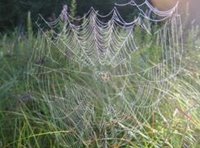Arunachaleswarar is reputed to always be on the mountain in disguise. There is a mysterious and sacred banyan tree on the Northern peak of the mountain and Maheswara, disguised as a Siddha, is believed to be always at the root of that great banyan tree. The shade of the tree is itself supposed to very mystical and conforming to the shape of a mandala.
22 July 2006
21 July 2006
Blog Address
Due to problems with ISP servers, currently we have a situation in this country that certain websites (mostly with a blogspot address) are difficult to connect to. This is a problem being particularly experienced by people with Reliance mobile internet connections. If you ever have problems accessing this site with the normal address, then please use alternate address:
Cow Day
Picture of the cow nursery next to my home. Even though these young 'uns have been taken away from their Mums, still they have a nice peaceful, clean environment to live in, lots of good food and plenty of company. My farmer neighbour has 28 cows at this time, and about 20 of them are babies.
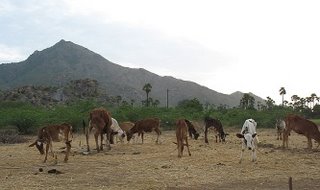
A local farmer on his way through the now waterless lakebed. Bullocks are still are major 'work' resource and are still used for transporting all types of loads, and they are still used for ploughing land - however tractors are beginning to be used by an increasing number of farmers.
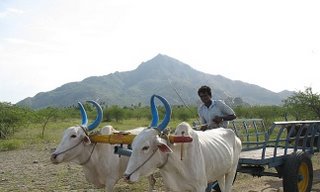
20 July 2006
The Sankaracharya

Sri Chandrasekharendra Saraswati, the 68th Sankaracharya of Kanchi, used to be referred to as 'Periyaval', the great one. He is remembered as one of the foremost religious teachers of the 20th Century and for his work towards upholding the Eternal Dharma, revitalising the study of the Vedas and for unifying Hinduism. The Sankaracharya always had a great love for Arunachala and in December 1929, visited Tiruvannamalai and attended the Deepam festival. He stayed for more than a month, and whilst at Arunachala, performed regular giripradakshina, attended pujas and ceremonies at Arunachaleswarar Temple and also gave spiritual discourses.
It was in 1931 whilst staying at Chingleput (Tamil Nadu), that a famous meeting with Paul Brunton occurred. The details of the meeting are mentioned in Bruntons, 'A Search in Secret India', a book which has been responsible for bringing many pilgrims and seekers to Arunachala. It was during that meeting the Sankaracharya advised the Englishman to go to Arunachala, as it was there he would meet his spiritual master and Guru, Sri Ramana Maharshi.
It was in 1931 whilst staying at Chingleput (Tamil Nadu), that a famous meeting with Paul Brunton occurred. The details of the meeting are mentioned in Bruntons, 'A Search in Secret India', a book which has been responsible for bringing many pilgrims and seekers to Arunachala. It was during that meeting the Sankaracharya advised the Englishman to go to Arunachala, as it was there he would meet his spiritual master and Guru, Sri Ramana Maharshi.
Hill Fires

The main work and accomplishment of the organisation The Mountain of Medicine, has been to combat the fires on Arunachala that rage each summer, leaving the Red Mountain black. Many are of the opinion that the slopes of the Hill are nearly barren, but some time spent upon them will reveal the opposite to be true. There are countless little remnant pockets of the forests that would have once covered the Hill and all over the slopes small trees are regenerating naturally, both from root stock of cut trees, and from seeds born by birds and the wind.
If this regeneration process is allowed to carry on unhindered, it dwarfs any efforts that could be made through plantings. The Mountain of Medicine, in conjunction with other local concerned bodies and individuals, has put a great deal of effort into a variety of strategies to prevent the Mountain from burning. Three years into the process, and the organisation is (cautiously) optimistic about the way things are going.
Whereas previously the entire Hill would burn each summer without anybody doing anything about it, now there is a situation where, in the event of fire, gangs of schoolboys go upon the slopes to fight it. The boys are accompanied by workers of The Mountain of Medicine and the State Forest Department. Preventive strategies have ensured that fewer fires start in the first place. In 2004 less than 25% of the Hill was burned, in 2005 less than 15% and so far this year less than 3%.
If this regeneration process is allowed to carry on unhindered, it dwarfs any efforts that could be made through plantings. The Mountain of Medicine, in conjunction with other local concerned bodies and individuals, has put a great deal of effort into a variety of strategies to prevent the Mountain from burning. Three years into the process, and the organisation is (cautiously) optimistic about the way things are going.
Whereas previously the entire Hill would burn each summer without anybody doing anything about it, now there is a situation where, in the event of fire, gangs of schoolboys go upon the slopes to fight it. The boys are accompanied by workers of The Mountain of Medicine and the State Forest Department. Preventive strategies have ensured that fewer fires start in the first place. In 2004 less than 25% of the Hill was burned, in 2005 less than 15% and so far this year less than 3%.
[Thanks to Govinda Bowley for this post)
19 July 2006
Miracle of Arunachala

Sri Siva:
Arunachala . . . abides as the bestower of all Siddhis - such as regaining eyesight to the blind, the ability to walk on (one's own) feet to the lame, begetting a son to the childless, ability to talk (fluently) to the dumb, conferment of all types of siddhis, dispelling all ailments and quelling of all sins."
[The Skanda Purana]
Lady Weavers
These are the ladies of the family who live in the Saint's compound. They are bamboo workers and are currently working on making shovel-like plates, which are used for winnowing and cleaning raw rice. It's fascinating to watch the transformation of the bamboo. The whole trunk will arrive in one piece, and the workers set upon it stripping it down bit by bit into whatever size they want. In the background you can someone fashioning long strips of bamboo which will be softened in water and then made into whatever the weaver wishes.
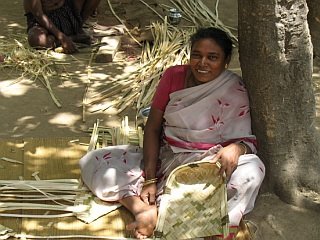
This is the weaver's mother. They told me she is over 70 years old and although she does in fact look it, I doubt she is that age. Indian ladies are deservedly renowned for their great beauty, however because of the harsh demanding life, the women in this country (particularly country ladies) do age quickly. As well as that, the ladies often experience problems with their backs, hips and internal organs even at a young age, very often because of harsh physical labour.

18 July 2006
Mahan Sajarat
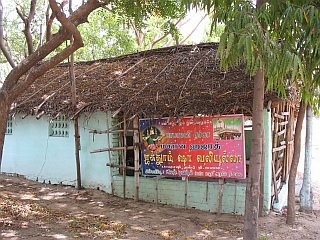
This is a favourite place of mine and one that is curiously undiscovered by most people. The samadhi is located in a large Moslem compound, which is inhabited by a family of basket weavers.
The actual name of this saint is Mahan Sajarat and the samadhi is called, The Baba Valle Durbha. Hopefully I will be able to get more information on this enigmatic and mysterious Master.
What follows is a short extract taken from the book In Days of Great Peace by Mouni Sadhu. Apart from the chapter in this book, the mystical powers of this spot have been referred to many other times and in particular by Ramana Maharshi devotees.
***********************
One day, a friend invited me to attend worship in the mosque of Tiruvannamalai. I went and was told the strange story of a North Indian Mohammedan saint, generally called Haji here. A few days before his death he said to his pupils:
When I leave my physical form, my Spirit will remain with you. Let everyone, without any difference of creed and social status, come to my grave whenever he may be in need of help. Let him express his need or wish as clearly as he would, were he facing my present visible form. I shall certainly hear his entreat and shall transmit it to the Most High, who will fulfil it for the sake of His servant .....
For me, the tomb of the Mohammedan saint proved to be one of these magnetic spots. in a few moments, after having excluded the visible words from my consciousness, I became aware of the Hajis presence. It was like that of a sweet and extremely kind person asking me what were my needs and wishes and urging me to express them frankly without any shyness or reservation .....
During the next weeks I returned several times to this silent shrine, having some entangled and difficult problems to solve. One of them seemed utterly hopeless, for its solution from the physical point of view was impossible. And yet, within three days after my last visit and request for the Hajis help, a happy and unexpected solution came of itself without intervention on my part.
Deus Monde
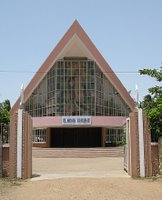
There are several large and well attended churches in Tiruvannamalai for the benefit of the sizeable Christian contingent in the city. This is the Catholic Church - Deus Monde - God of the World. It's quite beautiful, with a large well maintained compound. Inside the Church there is a lovely mural of the Mother Mary.
Wild Black Pig

This is a nice family outing - but the Mum looks much too junior to have produced such a brood - she definitely needs to do some more munching. There are fewer of these wandering pigs in the streets of Tiruvannamalai, as the city is getting more developed and there are less marshy, secluded spots for these pigs to take refuge in.
The pigs generally spend the days rooting around looking for food through the garbage and rubbish lying on the streets. There is a caste in Tamil Nadu that eat this pig - but other castes won't touch it - as it is very much regarded as unclean by most of the community. The sows are not culled - they are left alone to breed and repopulate the pig colonies - however the boars, sorry (!), head straight for the cooking pot once they've got nice and chubby.
Railway Station
The traditional method of travel to Arunachala used to be by rail. The sign (nowadays written in Tamil, Hindi and English), is the first thing one would have see after alighting from the train.

And this is the view of Arunachala from outside the Railway Station. Even with the electric cables and jumble of houses, a spectacular sight!

16 July 2006
All Change!
This is the new and supposedly efficient way (efficient - with all that pollution?). But please teach the drivers not to overtake and also teach them how to drive without leaning on their horn!
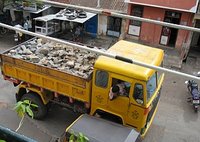
And this is the old way. Yes, more leisurely and less polluting - but pity the poor working beast. I'll even take the truck if it means that these underfed, overburdened and often abused creatures don't have to come into the busy, dangerous, noisy town. Keep them in the countryside p-l-e-a-s-e.

Puja times
Arunachaleswarar Temple:
1. Ushathkala 05-30 a.m.
2. Kalasanthi 08-00 a.m.
3. Uchikalam 11.30 a.m.
4. Sayarakshai 05-30 p.m.
5. Irandamkalam 07-30 p.m.
6. Ardha Jamam 09-00 p.m.
Apart from the above, special pujas known as Panchaparuva Pujas, namely, Amavasai, Kiruthigai, Pradosham, Pournami, Sathurthi, Sukravaram and Somavaram are celebrated.
Temple Services

An elaborate protocol of worship services mark each day at the Arunachaleswarar Temple where about a hundred and fifty people are attached to it, including; priests, musicians, singers, carpenters, potters, washermen, palanquin bearers, garland makers, administrators and watchmen.
The day begins with the ceremonial arrival of Ganga (holy water) to the shrine, from a tank in the Southern part of the town on an elephant through the Southern, Tirumanjana Gopuram. This water cleanses the entrance to the second prakaram, and then the next ritual involves the waking up of Shiva and Parvati in their bedchamber. The Shiva-Meru returns to the Annamalaiyaar shrine while the image of Parvati returns to the Unnamulaiamman shrine.
Six other pujas are offered at the temple, the first one at 5.30 a.m., and the last one at night where the Shiva Meru and the image of Parvati are brought in a procession into the bed chamber. Each service is accompanied by chants of dedication and praise. In the south west corner of the prakaram, the sacrificial fire ritual takes place, ending with the consecration of vessels of water which are used in the ablution of Annamalaiyaar and Unnamulai Amman.
Temple Origins

To resolve a dispute between Brahma and Vishnu, Sri Siva created a limitless Pillar of Light and challenged the Gods to find the Columns top and bottom. Brahma and Vishnu both failed in their tasks and subsequently prayed to the Lord that the blazing Pillar should establish itself as a Hill, and that Sri Siva should take the form of a Lingam on the east of the Hill. They also entreated that, as a remembrance of the Fiery Column, a Jyothi should appear every year on the top of the Hill during the time of Karthigai (i.e. period of Deepam).
Brahma's and Vishnu's prayers were granted and the blazing Pillar of Light became a Hill and a Lingam soon appeared at its foot on the south east side. For the purpose of worshipping that Lingam, which is no different to the Mountain, the Gods caused a great Temple to be built around it. A sacred tank was dug and filled with a mixture of all other Tirthas (sacred watering places) to provide water for the ablution of the Lord as Lingam. And nearby, for the abode of those striving for spiritual achievements, a great city Aruna (previous name for Tiruvannamalai) was built.
Brahma's and Vishnu's prayers were granted and the blazing Pillar of Light became a Hill and a Lingam soon appeared at its foot on the south east side. For the purpose of worshipping that Lingam, which is no different to the Mountain, the Gods caused a great Temple to be built around it. A sacred tank was dug and filled with a mixture of all other Tirthas (sacred watering places) to provide water for the ablution of the Lord as Lingam. And nearby, for the abode of those striving for spiritual achievements, a great city Aruna (previous name for Tiruvannamalai) was built.
14 July 2006
Pots and Pans

It's Friday morning and this gent is on his way to the market place. He has just come from canvassing homes either trying to sell some of his new shiny utensils or purchasing old metal scraps and implements that householders may have lying around. I checked out the big circular tub in the middle of the utensils - and it's full of metal scraps. Also lots of metal bits and pieces on top of his pyramid!
Everything is recycled and if you go down to some side streets close to the Big Temple you will see such men (as the above) with small charcoal fires melting pieces of scrap metal and pouring them into moulds to make either statues of idols or pieces of bric a brac.
13 July 2006
Electric Fusion!

This jumble of electric wires is a common sight on the streets of Tiruvannamalai - it looks like every electrician's nightmare! But saying that, the Tamil Nadu Electricity Board are providing excellent service. Some years back the City was plagued with power shortages and hours of electricity rationing - not anymore! This summer the electricity supply ran with hardly a blimp - very nice too!
E-Bikes Tiruvannamalai
E-Bikes bring good news to people interested in conserving energy, keeping Tiruvannamalai as pollution free as possible, and also helping their own pocket book!
This is the first time environment-friendly battery operated bikes have been available at Tiruvannamalai. These attractive little E-bikes, don't have petrol tanks, emit smoke or produce the roaring sound of a typical two-wheeler in the market. Four 12v high-end batteries attached to the vehicle feed the motor propelling the vehicle on the road. The batteries can be recharged time and again.
The owner of Sun E-Bikes, Tiruvannamalai told us that fully charged batteries will run the vehicle up to 50km at a maximum of 50kph. Since the batteries consume merely 0.8 unit of electricity, travelling 50km will cost Rs.1/-. Most importantly as the motor capacity of E-Bikes is below 50cc, there is no legal compulsion to either register the vehicle or possess a licence to operate it.
The Pondicherry Company (Planet-7 International) provides a one-year warranty for the vehicle. If well maintained, the 4-pack battery kit will last for at least 25,000 kms - new battery kits can be purchased later on. The Bike comes in lots of styles and colours. This definitely seems to be a step in the right direction in combating road pollution at Tiruvannamalai.
12 July 2006
Arunachala Service
In the Skanda Purana Sri Siva explains to his consort the efficacy of engaging in Arunachala service. He tells of the unimaginable blessings received by people who display their reverence and obedience to the Divine and illustrates the extent of those blessings by giving examples of the result of Arunachala service:
A spider, going about her business, spun a cobweb of threads in some spot around Arunachala. This inadvertent act was sufficient for the spider to reincarnate as a devotee with memory of its previous birth. The devotee returned to Arunachala with offerings of opulent silk cloths.

A glowworm of green colour came and made its nest in a branch nearby the Hill. The worm attained salvation because unintentionally its glow served in the place of a jyothi illuminating and worshipping Arunachala throughout the night.

A mouse inadvertently dragged a cluster of jewels into the sanctum sanctorum of the Siva Lingam of Arunachaleswarar Temple and thereby brightened the shrine. The worship was enough for the mouse to attain instant liberation.
Subscribe to:
Comments (Atom)


